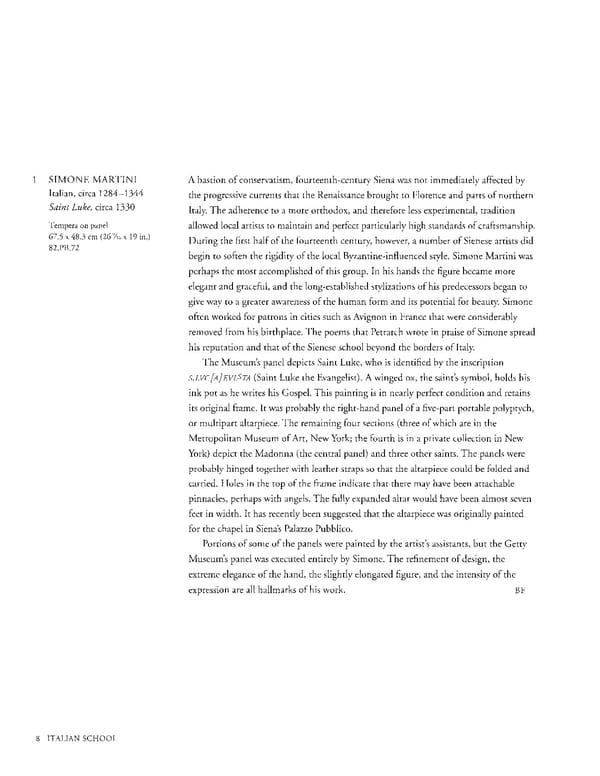1 SIMONE MARTINI A bastion of conservatism, fourteenthcentury Siena was not immediately affected by Italian, circa 12841344 the progressive currents that the Renaissance brought to Florence and parts of northern Saint Luke, circa 1330 Italy. The adherence to a more orthodox, and therefore less experimental, tradition Tempera on panel allowed local artists to maintain and perfect particularly high standards of craftsmanship. 67.5x48.3 cm (26 9/16 x 19 in.) During the first half of the fourteenth century, however, a number of Sienese artists did 82.PB.72 begin to soften the rigidity of the local Byzantineinfluenced style. Simone Martini was perhaps the most accomplished of this group. In his hands the figure became more elegant and graceful, and the longestablished stylizations of his predecessors began to give way to a greater awareness of the human form and its potential for beauty. Simone often worked for patrons in cities such as Avignon in France that were considerably removed from his birthplace. The poems that Petrarch wrote in praise of Simone spread his reputation and that of the Sienese school beyond the borders of Italy. The Museum's panel depicts Saint Luke, who is identified by the inscription S.LVC[A]EVLSTA (Saint Luke the Evangelist). A winged ox, the saint's symbol, holds his ink pot as he writes his Gospel. This painting is in nearly perfect condition and retains its original frame. It was probably the righthand panel of a fivepart portable polyptych, or multipart altarpiece. The remaining four sections (three of which are in the Metropolitan Museum of Art, New York; the fourth is in a private collection in New York) depict the Madonna (the central panel) and three other saints. The panels were probably hinged together with leather straps so that the altarpiece could be folded and carried. Holes in the top of the frame indicate that there may have been attachable pinnacles, perhaps with angels. The fully expanded altar would have been almost seven feet in width. It has recently been suggested that the altarpiece was originally painted for the chapel in Siena's Palazzo Pubblico. Portions of some of the panels were painted by the artist's assistants, but the Getty Museum's panel was executed entirely by Simone. The refinement of design, the extreme elegance of the hand, the slightly elongated figure, and the intensity of the expression are all hallmarks of his work. BF 8 ITALIAN SCHOOL
 Masterpieces of the Getty Museum: Paintings Page 8 Page 10
Masterpieces of the Getty Museum: Paintings Page 8 Page 10